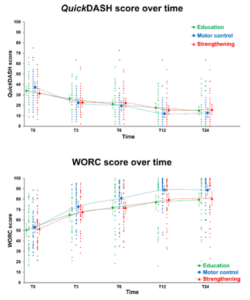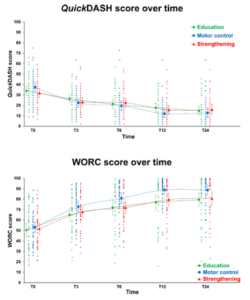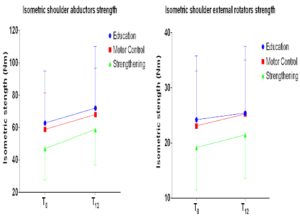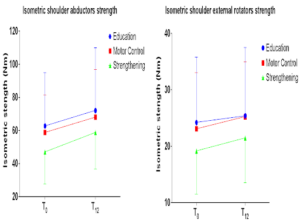Keywords: shoulder; education; exercises
In this blog, we will discuss the main results of a randomized controlled trial we conducted to compare three different frequently used ways of managing rotator cuff-related shoulder pain. Our study (recently published in BJSM) took more than two years to complete and was a collaboration between researchers from Canada (Université Laval and Université de Montréal) and the United Kingdom (1).
Why is this study important?
Shoulder pain is a frequent reason why people visit healthcare professionals. In many cases, this pain refers to structures in or around the rotator cuff: a group of four muscles that plays a crucial role in the shoulder. Besides pain, it can lead to other consequences such as decreased strength and mobility, as well as restrictions in work and social activities. In nearly 50% of people who have shoulder pain, the symptoms are present for more than 12 months. Despite many interventions available, nearly one-third of people with shoulder pain still have symptoms after treatment. This study is the first to compare strengthening or motor control exercises combined with education to education alone.

Source: https://stock.adobe.com/images/senior-woman-with-shoulder-pain/247435122?prev_url=detail
How did the study go about this?
We recruited 123 adults presenting with rotator cuff-related shoulder pain for the past three months at least. They were randomly allocated to one of three interventions lasting 12 weeks.
Education only: Participants in this group took part in an initial 30-minute session with a physiotherapist where they received information on their shoulder and their pain and advice on activity modification and the importance of healthy lifestyle choices (hydration, nutrition, sleep, physical activity, stress management). They also had to watch six short videos at home on those topics before discussing them with the physiotherapist during a second 30-minute session where any of their remaining questions were answered.
Education combined with motor control exercises: In addition to the same education intervention given to the first group, participants in this group underwent an exercise program aiming to facilitate shoulder movements to allow for a less painful movement and to reduce potential compensations.
Education combined with strengthening exercises: In addition to the same education intervention given to the first two groups, participants in this group received an exercise program aiming to increase strength through high loads.
To measure their evolution over time, participants filled out self-administered questionnaires evaluating their pain, their symptoms, and their functional level. We also measured the strength of two shoulder muscle groups.
What did the study find?
All three interventions led to significant improvements in pain and function over time. Both figures below show self-reported questionnaire scores at the different follow-up time points during the study (0, 3, 6, 12, and 24 weeks after the start of the intervention). As shown in both figures, the addition of exercises, either motor control or strengthening, to education did not lead to better results than education only.


In addition, both figures below show that strengthening exercises did not lead to additional strength improvement compared with education alone or education combined with motor control exercises.


What are the key take-home points?
- Healthcare professionals and patients may consider education as an effective intervention to help people with shoulder pain.
- The addition of exercises did not lead to better results in our study.
- It’s still unclear when adding motor control or strengthening exercises will be most helpful to help people with shoulder pain.
- More research is needed to single out patients’ personal or clinical characteristics that can help choose the best treatment.

References:
-
Dubé M, Desmeules F, Lewis JS, et alDoes the addition of motor control or strengthening exercises to education result in better outcomes for rotator cuff-related shoulder pain? A multiarm randomised controlled trial. British Journal of Sports Medicine 2023;57:457-463.
-
Lewis J. Rotator cuff related shoulder pain: Assessment, management and uncertainties. Man Ther 2016;23:57–68. doi:10.1016/j.math.2016.03.009
-
van der Windt DA, Koes BW, Boeke AJ, et al. Shoulder disorders in general practice: prognostic indicators of outcome. Br J Gen Pract 1996;46:519–23
-
Brox JI, Gjengedal E, Uppheim G, et al. Arthroscopic surgery versus supervised exercises in patients with rotator cuff disease (stage II impingement syndrome): a prospective, randomized, controlled study in 125 patients with a 2 1/2-year follow-up. J Shoulder Elbow Surg 1999;8:102–11. doi:10.1016/s1058-2746(99)90001-0
Authors and Affiliations:
Marc-Olivier Dubé, PT, MSc (1,2) marc-olivier.dube.1@ulaval.ca, François Desmeules, PT, PhD (3,4), Jeremy Lewis, PT, PhD (5), Jean-Sébastien Roy, PT, PhD (1,2)
1 Center for Interdisciplinary Research in Rehabilitation and Social Integration, Quebec City, Quebec, Canada G1M 2S8
2 Department of Rehabilitation, Faculty of Medicine, Université Laval, Quebec City, Quebec, Canada G1R 1P5
3 Orthopaedic Clinical Research Unit, Maisonneuve-Rosemont Hospital Research Center, University of Montreal Affiliated Research Center, Montreal, Canada
4 School of Rehabilitation, Faculty of Medicine, University of Montreal, Montreal, Canada
5 Therapy Department, Central London Community Healthcare National Health Service Trust, London, United Kingdom.
Twitter: @marco_dube, @fdesmeulesptphd, @JeremyLewisPT, @RoyJeanSebasti1